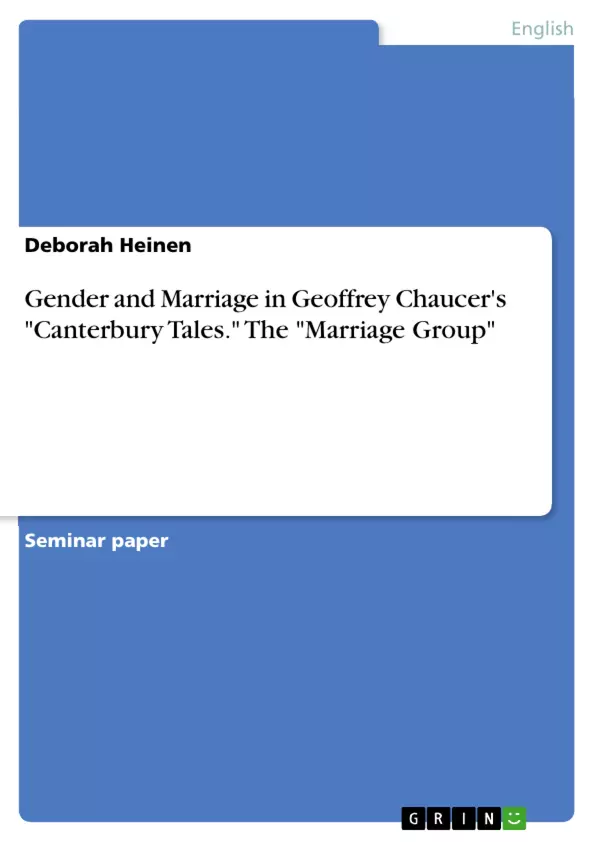“That he is a poet concerned with gender issues is obvious: almost every narrative in the Canterbury Tales deals with how the sexes relate to one another or envision one another” (Laskaya 1995: 11). Of course Laskaya talks about Geoffrey Chaucer and his famous work “The Canterbury Tales” from the 14th century, which is an unfinished collection of tales told by a group of pilgrims. Even though Laskaya accounts “The Canterbury Tales” as rich in gender issues, this work concentrates on four specific prologues and tales, the so called “Marriage Group”. The work in hand is supposed to discuss gender-specific aspects and gender-relations in the context of medieval society using the example of Chaucer’s “Canterbury Tales”.
Table of Contents
- Introduction
- Dominant Medieval Discourses on Gender
- Masculinity
- Femininity
- Marriage
- Gender and Marriage in Chaucer's “Canterbury Tales”
- The Wife of Baths Prologue and Tale
- The Clerk's Prologue and Tale
- The Merchant's Prologue and Tale
- The Franklin's Prologue and Tale
- Conclusion
Objectives and Key Themes
This work aims to analyze gender-specific aspects and gender-relations within medieval society, using the example of Chaucer's “Canterbury Tales”. It aims to provide a review and impression of how Chaucer incorporated the topic of gender and gender-relations in his work, highlighting the most striking aspects. Additionally, it attempts to decipher Chaucer's own attitude towards gender and gender-relations and his intentions in portraying his characters.
- Medieval discourses on ideal masculinity and femininity.
- Analysis of the "Marriage Group" in Chaucer's "Canterbury Tales" in relation to gender.
- Comparison of perceptions within the tales with dominant medieval discourses.
- Exploration of Chaucer's own attitude towards gender and marriage.
- The influence of cultural and societal norms on gender roles in medieval society.
Chapter Summaries
- Introduction: This chapter introduces the context of gender issues in Chaucer's "Canterbury Tales," particularly focusing on the "Marriage Group," and explores the challenges of understanding medieval perspectives on gender and marriage.
- Dominant Medieval Discourses on Gender: This chapter delves into the prevailing medieval discourses on masculinity and femininity, examining four distinct types: heroic, Christian, courtly love, and intellectual. It explores the ideal traits and expectations associated with each discourse and their implications for gender relations.
- Masculinity: This section elaborates on the heroic, Christian, courtly love, and intellectual discourses of masculinity, highlighting their specific values, ideals, and views on women's roles. It also discusses how these discourses shaped societal expectations for men and their power dynamics within medieval society.
- Femininity: This section examines the dominant medieval discourse on femininity, focusing on the male perspective and its emphasis on women as physical objects and their sexuality. It discusses the duality of perceiving women as both beautiful and chaste, yet simultaneously susceptible to lasciviousness and seduction.
- Marriage: This section explores the significance of marriage in medieval society, emphasizing its role in maintaining order, stability, and social acceptance. It discusses the factors contributing to marriage, including economic reasons and the Church's emphasis on procreation and morality.
Keywords
The main keywords and focus topics of this work include: medieval discourses on gender, masculinity, femininity, marriage, "Canterbury Tales," Chaucer, "Marriage Group," gender relations, societal norms, cultural expectations, and historical analysis. The text delves into the complex intersection of these themes to shed light on the dynamic interplay between gender and society in the Middle Ages.
- Quote paper
- Deborah Heinen (Author), 2014, Gender and Marriage in Geoffrey Chaucer's "Canterbury Tales." The "Marriage Group", Munich, GRIN Verlag, https://www.grin.com/document/275861



